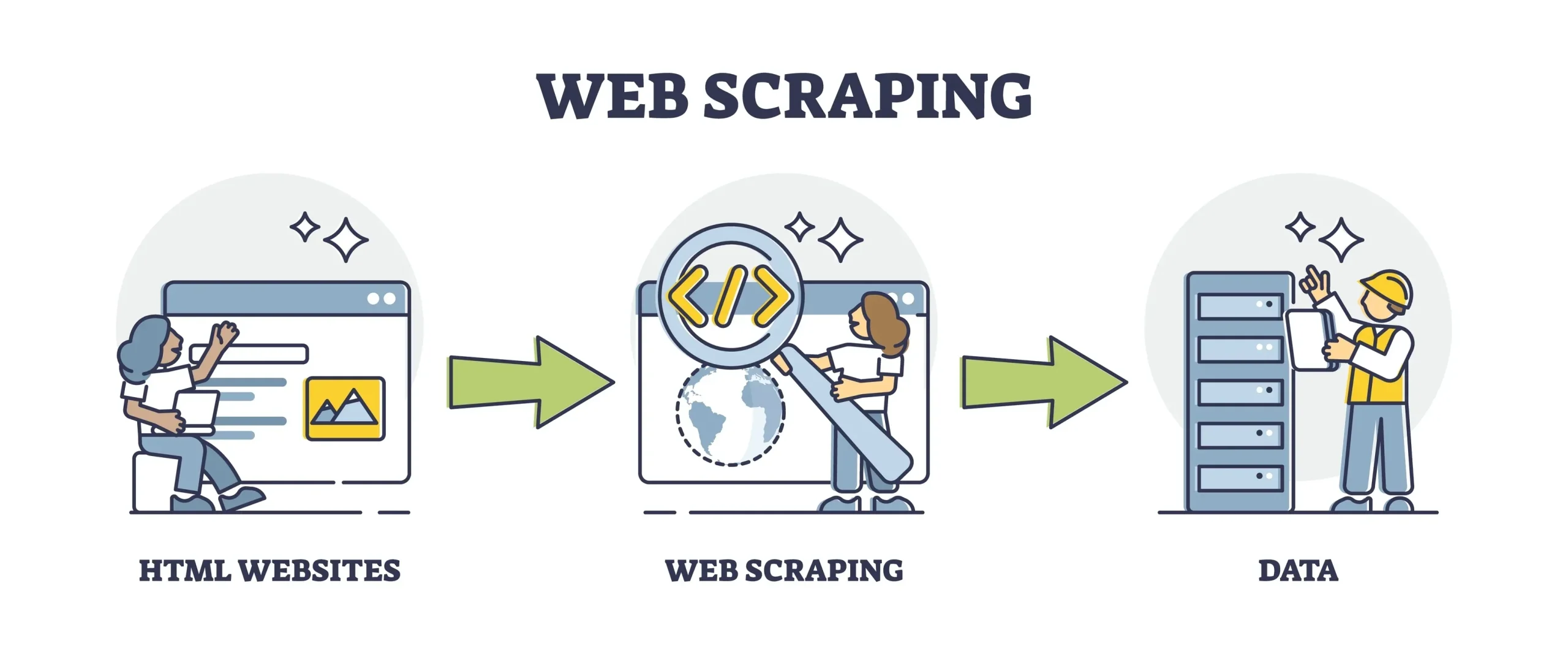Web scraping techniques are essential tools in the modern data-driven landscape, allowing individuals and businesses to extract valuable information from various websites effortlessly. By employing effective scraping tools like Python web scraping libraries, users can automate the extraction process, saving time and effort. For those eager to dive into this skill, a Beautiful Soup tutorial can serve as a valuable resource to guide beginners through parsing HTML and XML documents. Moreover, understanding the nuances of data extraction is critical, especially when dealing with dynamic content or complex web structures. This web scraping guide will help you navigate the intricacies of web scraping, ensuring you harness the power of data from the internet responsibly and efficiently.
Exploring the world of data gathering from online resources opens up a realm of possibilities for businesses and researchers alike. Techniques for harvesting website content, including automated data collection methods, present both challenges and opportunities in this digital age. With a plethora of options available, such as Python-based scraping frameworks and detailed instructions for beginners, mastering these processes can yield significant benefits. By utilizing state-of-the-art scraping methodologies and staying compliant with web standards, users can unlock insights from vast amounts of digital information. This exploration into the various strategies and tools for effective content gathering marks the beginning of a rich and rewarding journey into the realm of online data acquisition.
Understanding Web Scraping Techniques
Web scraping techniques enable individuals and businesses to gather data from the web efficiently. By using methods like HTTP requests and HTML parsing, developers can extract desired information without manual efforts. The foundational knowledge of web scraping revolves around understanding various tools and programming languages, with Python being one of the most widely used due to its simplicity and extensive libraries. In particular, libraries like Beautiful Soup and Scrapy offer powerful functionality for navigating through HTML structures, making it easier to locate and gather specific data.
Moreover, web scraping techniques are not just limited to text extraction; they also encompass the ability to scrape images, links, and metadata from various web pages. This automation of data collection allows users to analyze and utilize information from multiple sources effectively. Understanding the website’s layout and its Document Object Model (DOM) is crucial in ensuring that your scraping script captures the right elements. Thus, mastering web scraping techniques can significantly enhance your capabilities in data analysis and content understanding.
Choosing the Right Scraping Tool
When embarking on a web scraping project, selecting the right scraping tool is critical for success. Among the popular tools, Beautiful Soup is renowned for its intuitive design, which interfaces seamlessly with Python. It simplifies web scraping by allowing developers to extract data from HTML and XML documents easily. Another notable player is Scrapy, which not only provides a framework for web crawling but also an integrated system to store scraped data in various formats. Understanding the features of these tools enables users to select the one that best fits their specific scraping needs.
While Beautiful Soup is excellent for beginners due to its simplicity and functionality for smaller projects, Scrapy is geared towards larger-scale scraping operations. It offers robust features like handling multiple pages and managing scraping queues efficiently. Users should assess their project requirements against the strengths of each scraping tool. For example, if your goal is to scrape multiple pages or handle complex site logic, Scrapy might be the superior choice. Conversely, for a straightforward task involving a single page, Beautiful Soup could provide a quicker and more manageable solution.
Writing Effective Web Scraping Code
The process of writing effective web scraping code relies heavily on understanding the structure of the HTML Document Object Model (DOM) and utilizing the right libraries to parse that structure. Starting with sending an HTTP request to the target URL, it’s essential to receive a valid response before moving on to parsing the content. Using libraries like Requests in conjunction with Beautiful Soup can streamline this process, allowing developers to focus on the extraction logic rather than setup complexities. This combination enables the script to fetch HTML, target specific tags, and extract their inner content.
Once the HTML content is parsed, the next step is to write robust extraction logic. This involves identifying patterns and paths within the HTML hierarchy that lead to the desired data elements, such as article text, titles, and publication dates. Developers may use CSS selectors or tag-based searches to pinpoint information quickly. Careful handling of edge cases—like missing data or changes in the site’s structure—is crucial for ensuring that your code remains functional over time. Structuring the scraped output in a clean format, such as JSON or CSV, further enhances the usability of the extracted data.
Storing Your Scraped Data
After successfully extracting data from a webpage, the next fundamental step is storing that data in a structured format. Popular formats for data storage include CSV, JSON, and databases like SQLite or MongoDB. Choosing the right format often depends on the nature of the data and the intended use case. For instance, if you require easy readability and sharing capabilities, CSV might be the ideal choice. However, for complex data structures or large datasets, JSON provides a more flexible and scalable solution.
Storing data efficiently not only makes it easier to analyze later but also saves time in the long run. Utilizing Python’s pandas library can simplify the conversion of extracted data into a DataFrame, allowing users to manipulate and analyze tabular data effortlessly. Additionally, it is advisable to implement a systematic naming convention and folder structure for storing scraped data files, especially if conducting large-scale data collection. This practice ensures that data retrieval and analysis processes remain organized and efficient.
Respecting Robots.txt and Legal Considerations
When engaging in web scraping, it’s imperative to respect the site’s robots.txt file. This file communicates the rules established by the website’s owner regarding which pages can or cannot be scraped. By adhering to these guidelines, you not only align with ethical scraping practices but also protect yourself from potential legal issues that could arise from unauthorized data extraction. Ignoring the robots.txt file and scraping restricted pages could lead to IP bans or legal actions.
In addition to respecting robots.txt, it’s essential to familiarize yourself with the legal implications of web scraping in your jurisdiction. While many websites permit scraping for personal use, others may have strict policies against it, particularly regarding data ownership and copyright infringements. Understanding these policies is crucial to ensure that your scraping activities remain legal and ethical. Always consider seeking permission from the website owner to avoid conflicts and foster a respectable relationship in the online community.
Building a Web Scraping Guide
Creating a comprehensive web scraping guide involves detailing every step of the scraping process, making it accessible for both novice and experienced programmers. This guide should encompass everything from selecting the right tools to the nuances of writing effective scraping scripts. Including examples and code snippets showcasing the use of popular libraries like Beautiful Soup or Scrapy can greatly assist users in grasping the concepts. Structured tutorials can help facilitate learning and encourage best practices in web scraping.
Furthermore, a good web scraping guide should also focus on troubleshooting common issues that might arise during scraping, such as handling timeouts, managing request headers, and mitigating bans from websites. Offering insights into debugging techniques, such as using browser developer tools or checking response codes, can empower users to overcome obstacles efficiently. Additionally, case studies or practical applications of web scraping can showcase its potential, inspiring readers to explore various data extraction projects.
Integrating Data Extraction Workflow
Integrating web scraping into a broader data extraction workflow can greatly enhance productivity and data insights. This involves creating automated scripts that regularly scrape data, allowing for real-time insights and updates. Tools such as Apache Airflow or cron jobs can facilitate the scheduling and execution of scraping tasks, ensuring that data is continually harvested without manual intervention. Automating the process reduces the likelihood of human error and ensures that the data remains consistent.
Moreover, combining scraped data with other data sources can lead to more profound analytical insights. For instance, integrating social media data with scraped webpage content can provide a more holistic view of users’ sentiments regarding certain topics. Employing data analysis techniques, such as sentiment analysis and trend identification, on the collected data can offer valuable insights for businesses and researchers alike. An effective integration of scraping with analytics tools can transform raw data into actionable intelligence.
Advanced Data Processing Techniques
Once data is collected through scraping, employing advanced data processing techniques can maximize the insights gained from that data. Techniques such as natural language processing (NLP) can be invaluable for analyzing text data sourced from web pages. Applications like sentiment analysis, topic modeling, and keyword extraction can yield deeper understanding, revealing what topics are most discussed and how audiences react to them. These sophisticated techniques enhance the value derived from web scraping.
In addition, leveraging machine learning algorithms on previously scraped datasets enables predictive analytics. For example, a developer could analyze trends from news articles to predict future events or insights. By implementing data mining techniques alongside web scraping, users can uncover patterns that may not be immediately apparent. This fusion of web scraping and data science can drive innovative solutions in various fields, from marketing to scientific research.
Learning Through Beautiful Soup Tutorial
A Beautiful Soup tutorial serves as a fantastic entry point for beginners looking to dive into web scraping using Python. This library makes it easy to navigate and manipulate the parse tree of HTML documents, making it simpler to extract the necessary data. A well-structured tutorial should start with explaining how to install Beautiful Soup along with its dependencies and setting up the environment. Following this, step-by-step examples should demonstrate how to make HTTP requests, parse HTML documents, and extract data using different selectors and methods.
As learners progress, more complex topics can be introduced, such as handling pagination, searching for multiple elements, or working with forms. Incorporating real-world examples, such as scraping product prices or job listings, can keep the tutorial engaging and applicable. Additionally, providing tips and best practices for web scraping with Beautiful Soup ensures that learners grasp the essential ethical and technical considerations of web scraping.
Frequently Asked Questions
What are the best scraping tools for web scraping techniques?
When it comes to effective web scraping techniques, popular scraping tools include Beautiful Soup, Scrapy, and Selenium. Each tool offers unique features and benefits suitable for various data extraction tasks, making them essential for anyone looking to perform Python web scraping.
How do I get started with a Python web scraping tutorial using Beautiful Soup?
To start with a Python web scraping tutorial using Beautiful Soup, you should first install the library with pip. Then, familiarize yourself with basic commands to send HTTP requests and parse HTML content, allowing you to navigate and extract data easily.
What is the importance of inspecting the page structure in web scraping?
Inspecting the page structure is crucial for successful web scraping, as it helps you identify the specific HTML tags and classes that contain the data you wish to extract. This understanding allows you to write precise scraping code to accurately gather the required information.
What is a general web scraping guide for beginners?
A good web scraping guide for beginners includes choosing the right scraping tools, learning to inspect page elements, writing scraping scripts to fetch and parse data, and ensuring compliance with web scraping ethics by respecting robots.txt protocols.
How do I extract data from a web page effectively?
Effective data extraction from a web page involves selecting a suitable scraping tool, understanding the site’s HTML structure, crafting a script that fetches and parses the relevant content, and storing that information in a structured format for future use.
What should I know about web scraping ethics and compliance?
When practicing web scraping techniques, it’s important to be aware of web scraping ethics, which include respecting the site’s terms of service, analyzing the robots.txt file to determine allowed scraping activities, and not overwhelming servers with excessive requests.
Can I scrape dynamic web pages with Python web scraping?
Yes, you can scrape dynamic web pages using Python web scraping tools like Selenium or Puppeteer. These tools can automate browser actions and handle JavaScript-rendered content, allowing you to capture dynamic data that traditional scraping methods may miss.
What format should I use to store extracted data from web scraping?
Extracted data from web scraping can be stored in various formats, but the most common are JSON and CSV. JSON is great for hierarchical data, while CSV is useful for tabular data, making both formats ideal for data manipulation and analysis.
How do I handle errors while performing web scraping?
To handle errors in web scraping, implement try-except blocks within your scraping code to catch HTTP errors, timeouts, or parsing issues. Additionally, adding logging can help you identify what went wrong during the scraping process.
| Step | Description |
|---|---|
| 1. Choose a Web Scraping Tool | Select a tool like Beautiful Soup, Scrapy, or Puppeteer based on your programming preference. |
| 2. Identify the Target URL | Determine the specific URL of the article you intend to scrape. |
| 3. Inspect the Page Structure | Use browser developer tools to analyze the HTML structure and locate desired content tags. |
| 4. Write the Scraping Code | Create a script to send requests, parse HTML, and extract elements based on identified tags. |
| 5. Store the Extracted Data | Save the scraped data in formats like JSON or CSV for further use. |
| 6. Respect the Robots.txt | Always check the site’s robots.txt file to ensure compliance with scraping rules. |
Summary
Web scraping techniques are essential for extracting data from websites efficiently. To successfully scrape data, one must choose the right tools, identify target URLs, inspect the HTML structure of the pages, write the appropriate code for data extraction, save the data in a usable format, and adhere to the site’s terms by respecting the robots.txt file. Following these techniques ensures a comprehensive and compliant scraping process.



